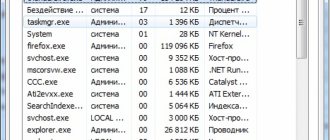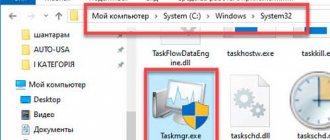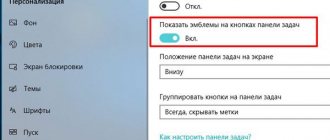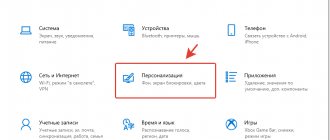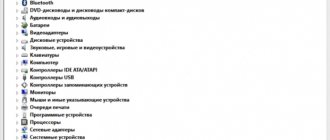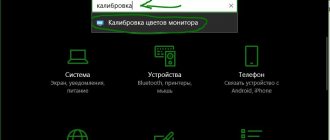5
(2)
Inexperienced users don't come across Task Manager very often, but this system utility is actually very useful. For example, through it you can close a frozen process or see which program is so zealously “biting off” RAM and laying claim to processor resources, or find out the IP address of a computer on the local network. Today we’ll talk about how exactly you can open the dispatcher. There are many ways - we will try to consider them all.
Using keyboard shortcuts
First, let's talk about what “hot keys” or “hotkeys” are, which are often mentioned in instructions. This term may be unclear to inexperienced users.
“Hot” are standard keyboard shortcuts. They were named that way because of their frequent use. The combinations can be either general, i.e. act both in system applications and in application applications, as well as specific ones, working in a specific program. In this case, we are talking about a combination that always works in Windows, regardless of the type of program running and the type of device - PC or laptop.
When using “hot” combinations, the buttons must be pressed simultaneously! This is the main condition, since otherwise the combination may not work, or will lead to a result different from what was originally expected!
Ctrl + Shift + Esc
Everything is very simple. Press and hold the keys indicated in the title.
After this, you can look at the task manager window.
More experienced users can immediately ask a completely logical question: “Why use this particular combination at all - after all, it’s much more common to use Ctrl + Alt + Del”?!
It’s simple - this combination is universal, and works not only in the case of a “physical” machine, but also in the case of a virtual machine.
For reference: “virtual” is a system that runs in the “parent” OS in a separate window. You can come up with many scenarios for its use - for example, on a virtual machine they often test potentially suspicious applications that are undesirable to run in a working environment.
The same combination works when working with a remote desktop. This is the name of a special access mode in which the user can use the resources of a remote device by working with it directly.
In a word, if you always want to launch the dispatcher in any situation, it won’t hurt to learn the combinations of these three keys.
Ctrl + Alt + Del
The most common and well-known combination, a sort of “holy trinity” of every self-respecting Windows user.
After pressing these buttons simultaneously, the same “Dispatcher” will appear in front of the user. But... Not in all cases. If you try to use this method in the OS, starting from Windows 8 onwards, you will see something not quite familiar...
But if you look closely, you can see an item with the desired name below.
To launch the Manager, you just need to left-click on it.
Or you can simply use the combination Ctrl + Shift + Esc suggested above. Well, or continue reading the article further, because hotkeys are far from the only way to launch this application! Although you will agree that they are very convenient to use, for this case we have an article about hot keys in Windows 10.
What is Explorer on a PC?
Explorer on a computer is a special program with which you can work with various folders and files located on the PC. It is often located in the Start menu. Using the designated program, you can copy, delete and rename files, as well as move them.
In addition, you can perform the noted actions with existing directories on your personal computer. After opening the program, all folders and files will be presented on the left side of the screen, from which you can open the one you need. It should also be noted that the displayed folders have their own tabs. To view all attachments, you will need to click directly on the icon next to the folder in this option, it is a small triangle.
To do this, open the designated menu (“Start”) and click on the “All Programs” section, where the available folders will be displayed. Then, by double-clicking the computer mouse on the “Standard” item, you need to open the “Explorer” option. You can also note several more ways that allow you to open a program using the “Task Manager”.
It should be said that in order not to look for the “Standards” option in the Start menu, you can open the designated menu and press the Ctrl + Esc key combination, holding them down, click on the arrow on the keyboard showing the actions to the top.
Available options
One of the easiest ways to perform the indicated actions is to press the keyboard shortcut Ctrl + Alt + Del. After this, a list of functions will be displayed on the screen, among which there will be the “Task Manager” item; you need to open it.
Then, in the window that appears, you will need to click on the “File” option located in the upper left part of the dialog box that appears. When you click, a small additional menu will appear in which you need to select the line “New task (run)” for those users who have Windows 7 installed or “Run a new task” if Windows 8 is installed.
Next, a new window will open on the screen, in which you will need to enter the official name of the explorer - explorer. You also need to confirm your actions by clicking on the “Ok” button.
After these steps, all the necessary attributes of the operating system will be displayed on the taskbar.
For windows XP and Seven
Another option for calling the “Explorer”, which is also simple and convenient, at the same time reduces the execution of actions by three points than those presented in the previous method. In this case, you will need to perform several steps.
- simultaneously press and hold the “Win” + R keys;
- in the window that appears you will need to write “explorer.exe” (without quotes);
- To confirm the steps taken, click on “Ok” or “Enter”.
Using the taskbar
Perhaps a real lifesaver for inexperienced users, allowing them to call the dispatcher without using any keyboard shortcuts at all. You just need to move the mouse cursor to the panel, right-click over it and select the appropriate item in the context window that appears.
In the "seven" everything looks similar.
Everything ingenious is simple! But there are situations when the taskbar is jam-packed with open application windows, and there is basically no free space on it. In this case, such a simple and convenient method may not work. But, as you might have guessed, there will still be a solution!
Program overview
Now that we've figured out how to launch the task manager, let's take a closer look at it. Let's say right away: when the system monitor is launched for the first time, you will see a very small square that has no functions at all.
To open full functionality, simply press the marked button.
Usually, when users see such a compact view of the utility, they think that the tabs are gone and start asking us why the task manager does not open completely.
Processes
The “Processes” tab displays a number of applications and system processes that can be organized by name, load on the CPU, RAM, Video card, etc. Using this tab, we can unload a “frozen” application or see what is “slowing down” the PC.
Performance
It contains graphs that show in real time the load on various computer hardware components.
Magazine
All applications that put a strain on our PC resources are displayed here. Also, all indicators are divided into categories. The time during which this or that software loaded the system is also indicated.
Autoload
The startup menu displays a list of software that starts with Windows in automatic mode. If there are too many components, the OS will also load slowly.
We recommend removing unnecessary things by simply right-clicking on the desired program and selecting “Disable”.
Users
This section displays a list of all users who are currently using the PC.
Details
The “Details” item, like the “Processes” section, contains all applications currently running. The difference between this menu is the ability to display the home directory of the running process. In the screenshot you see how using the context menu you can open the path to one of the processes.
Using this functionality, you can find the software that loads our PC and go to the directory with its executable file.
Services
Well, the last tab displays running and idle services.
Attention: if the program does not start, system restore may help you. We show it using Windows 8 as an example.
Main menu
There is also a main menu that allows you to launch Explorer through the manager or call any other application. In order to do this, simply click “File” - “Run a new task” and select the desired software. For Windows Explorer, this is “explorer.exe”.
Using “Windows Search”
Everything is very simple. In Windows 10, there is a magnifying glass icon near the Start button. Click on it, and in the input field that appears, we begin to write “Dispatcher...”. Since the search system in the “top ten” is really “smart”, it will quickly suggest the desired option. All you have to do is left-click on the appropriate item. And by the way, the search can be changed; read about this in the article on how to remove search in Windows 10.
In Windows 8/8.1 everything is similar, but in Windows 7 it’s a little different. Click on the “Start” button and find the input field.
In it, enter “Dispatcher” again, after which we click on the appropriate item with the left mouse button.
In this case, the required item is called “View running processes in the task manager.”
Still, searching in the top ten is much more intelligent - this is one of the clear advantages of this system.
However, this is not relevant to the point, and we continue to analyze ways to launch the “Dispatcher”.
Press Ctrl + Alt + Delete
A combination well known to everyone without exception. In older versions of Windows, using these keys would instantly launch the Task Manager. Starting with Vista, this combination was used to display the system security screen.
Press Ctrl + Alt + Delete, and you will be offered options: lock the computer, switch to another user, log out, and, in fact, open the Task Manager.
Standard utility “Run”
If you are not yet tired of flexing your fingers on the “hot keys”, you can use the combination of the Win and R buttons (the latter button will work regardless of the layout).
After clicking them, the standard “Run” utility window will appear.
Copy and paste the taskmgr.exe command into it, and then click “OK”.
How to launch Explorer in the standard way on different systems?
As a rule, users new to Windows OS follow standard instructions. In their understanding, the question of how to launch Explorer comes down to finding the appropriate application in the main Start menu.
But this is a lot of unnecessary actions. You need to click on the start button, find the programs section in the menu, select standard applications (or another section depending on the OS modification) and only then click on the name of the application to be launched. Agree, this takes quite a lot of time.
Using the command line
Do you want to feel like a “hacker” from Hollywood movies? No question - to do this, try calling “Dispatcher” using the command line. It’s easy to find it - in the search field, which we already talked about above, start typing “Command...”.
We click on this item with the left mouse button, after which the good old runtime environment opens...
We copy the same taskmgr.exe command. Right-click on any free space in the “black window” and... the command is automatically inserted.
All you have to do is press Enter!
Owners of Windows 8/8.1 will do the same thing, but Windows 7 users are out of luck - Microsoft did not introduce the implementation of the “Paste” command via the right mouse button into this system. So you will have to enter the phrase taskmgr.exe manually...
If you make a mistake, it's okay. In this case, the system will write “Command not found.”
Power User Menu
Starting with Windows 8, Microsoft hid some of the system software in the corners of the Metro interface, but left the ability to launch it from the “Advanced User Menu”. You can launch it in two ways.
First, press the key combination Win + X (here the last letter is the Latin “X”)
The second method is even simpler - click on the “Start” button with the right mouse button. In both cases, a window will open on a black background, where you need to select the item you are interested in by clicking on it with the left mouse button.
An attentive user, by the way, may have already noticed that from the same menu you can call up the Command Prompt (and you can do it with administrator rights), open the “Run” utility window and do a number of other necessary things. You can experiment at your leisure!
Let us repeat once again - Windows 7 and earlier versions of Windows do not have this function!
Just in case
Here are a couple more unusual ways to open Windows Explorer:
- Through the same small “Run” window as we called in the previous instructions. Without the Manager, it is launched using the Win + R key combination, and then the actions are similar.
- From the command line. You can find it in the Start menu among the standard programs. When you open it, enter the start command. (dot is required) and press Enter - the current directory will appear in front of you. To start the parent directory, put two dots after the word.
Task Manager executable file on the system
Again we go to the search field, which has already been mentioned several times above, and paste there (Ctrl + V or right mouse button - “Paste” command) the line taskmgr.exe.
On the right side of the window that opens, select “Open folder with file.”
An Explorer window will open, where the system utility file itself is located.
Or you can cheat and, bypassing all these points, open any Explorer window (even “My Computer”) and, right-clicking in the address bar, use the “Paste” command to enter the following path there:
C:\Windows\System32
Then press Enter and immediately go to the desired folder. And if you don’t want to search among a scattering of files for the one you need, immediately enter in the same line:
C:\Windows\System32\taskmgr.exe
And press Enter again. The task manager you are looking for will open immediately!
For dialog boxes
Individual commands are assigned to dialog boxes, which can be opened by any of the previously designated combinations.
| Combination | Description |
| "F4" | Display components from the active list. |
| "Ctrl" + "Tab" | Go to the next window. |
| "Ctrl" + "Shift" + "Tab" | Go to the previous window. |
| "Ctrl" + any number | Go to a specific tab. |
| "Tab" | Switch forward between options. |
| "Shift" + "Tab" | Switch back between options. |
| "Space" | Check or uncheck the box. |
| "Backspace" | Open the folder located one level higher. |
Create a shortcut on the taskbar
In order not to break your fingers with hotkeys and not constantly copy commands, you can make it even simpler - add the desired shortcut to quickly call the utility directly to the Taskbar. Make it easier than ever!
First, open the “Dispatcher” using any of the methods described above. It is necessary for its window to appear on the Taskbar.
After that, right-click on it and select “Pin to panel...” from the context menu that appears.
Create a shortcut on the desktop
If there is simply no free space on the Taskbar, you can do it even simpler and create a shortcut to launch the utility directly on the Desktop.
To do this, you need to right-click on any free space on the table (if there is one), and select “Create-Shortcut” in the context menu that appears.
A settings window will open where you need to enter the path to the object... The attentive reader already knows what this item is:
C:\Windows\System32\taskmgr.exe
Paste this value into the appropriate field and click on the “Next” button.
After this, the system will offer to somehow “name” the created shortcut. You can enter something of your own, you can leave the proposed option - the performance of the solution will not be affected in any way.
Click “Done” and admire the ready-made shortcut for quick access!
That's all! From now on, by simply clicking on it with the left mouse button, you can always launch the “Dispatcher”.
We also suggest that you read the article on how to create a shortcut on the Desktop.
Alternative Windows task management utilities
The task of monitoring and managing processes has prompted a number of developers to create alternative solutions. Enthusiasts have developed utilities that implement both individual, in-demand functions of the dispatcher, and software that significantly expands its functional capabilities.
KillProcess
Since the majority of users use the task manager only to terminate harmful or frozen applications, there are utilities that implement only this action. One of the most successful process killers is the KillProcess utility from Orange Lamp. The application is capable of generating lists of processes that will be completed with one click. In addition, the utility can terminate even Microsoft-protected processes and keep track of the number of processes allowed and prohibited from running. The application can be downloaded both as an installer and a portable version that does not require installation.
The utility is capable of unloading several processes in one click
Daphne
Initially, Daphne was designed as a convenient tool for “killing” frozen processes, but with each subsequent version it acquired more and more new functions. The Daphne interface consists of a top panel with data on the intensity of PC resource usage and system operating time, as well as a window with a list of all current processes. Each line provides detailed information about the process, including a command line with startup options. All operations with processes are performed using the context menu. In addition to standard functions, it is possible to complete the process at a designated time, search for information about the process in the developer’s database, and also create a “trap” for the process. The “trap” monitors the behavior of the selected application and, when certain conditions occur, performs one of the proposed actions on the process.
The most “gluttonous” applications in the list are highlighted in color
Free Extended Task Manager
Free Extended Task Manager is an almost complete analogue of the standard Windows task manager. Its advantages over the built-in solution are monitoring of hard drive activity, information about the use of computer network ports, and the ability to find the process blocking it by file name.
The difference from the standard task manager is that it monitors the activity of not only the processor and RAM, but also disks
Process Explorer
Utility from Mark Russinovich and Sysinternals. Process Explorer is recommended by Microsoft as an alternative to Task Manager in Windows. The program does not require registration or installation. In the utility settings, it is possible to install Process Explorer as a replacement for the standard task manager.
The utility window displays a list of running processes, and to the right of it there is a table with brief information about them. In the lower panel of the program, you can configure the display of additional information about the process of interest. All standard manipulations with processes and tasks are available, viewing the intensity of use of the central processor, RAM, and disks.
Microsoft recommends this product as an alternative to the standard task manager
System Explorer
The System Explorer utility implements all the functionality of the standard Task Manager. Additionally, it includes several options unique to it. Developers maintain their own database of processes, so when the utility is launched for the first time, the user is prompted to check running tasks against records in the database. In addition to operations with processes, the program allows you to manage startup parameters and create system snapshots (files + registry) to track changes made by programs. It also provides tools such as calling system utilities, displaying information about drivers and currently open files.
The abundance of functionality of the System Explorer utility will pleasantly surprise even discerning users
AnVir Task Manager
It’s not for nothing that the developers of AnVir Task Manager compare their brainchild to a Swiss army knife. This utility has almost everything. The Russian version of Anvir Task Manager is completely free. The user will be provided with complete information about running applications, processes and libraries, data on open network connections, the ability to manage the startup list and track changes in it. The utility can even detect and remove viruses and spyware, and blocks attempts to infect the system.
The analysis is based on the characteristics and behavior of the program, as well as information from an integrated database containing records of 70,000 startup programs, Internet Explorer toolbars and system services.
AnVir
https://www.anvir.net/press-reliz.htm
Packed with all sorts of functions and modules, like a Swiss army knife
Anvir Task Manager will also help the user with setting up the operating system. In general, the AnVir utility is a jack of all trades; it can be safely recommended to users of any level as a very successful and functional replacement for the standard Windows task manager.
DBC Task Manager
For those “Seven” users who like the new task manager from Windows 8, but are not eager to change the time-tested system because of this, we can recommend using the DBC Task Manager utility. It completely reproduces the appearance and basic functionality of the task manager of an older version of Windows. The program does not require payment and is available in both 32- and 64-bit versions. The utility does not make any changes to system files and the registry, since it is distributed only as a portable version.
An almost complete copy of the Windows 8 task manager, designed for Windows 7 and Windows Vista

